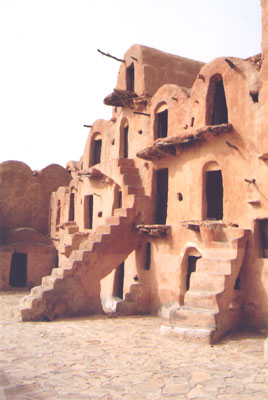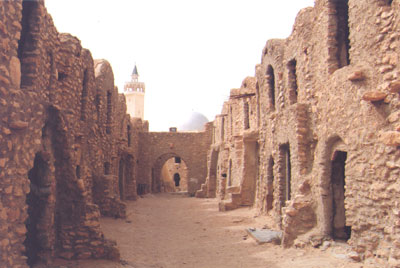Tunisian odyssey: Finale
This item appears on page 61 of the September 2010 issue.
by Julie Skurdenis (Third of three parts)
For my husband, Paul, and me, this was the last part of a 22-night trip through Tunisia that began in the north of the country in Carthage, one of Tunisia’s prime archaeological sites, and ended on the island of Jerba in the Mediterranean just off the coast of Tunisia.
The first two weeks of our trip had been full of Numidian, Phoenician, Roman and Byzantine archaeological sites as well as medinas, souks and museums interspersed with large doses of natural beauty. It was in the latter part of the trip that we first encountered the Sahara with its seemingly endless vistas of sand and with occasional herds of camels munching sparse tufts of desert grass.
Berber ksour
It was also here in the Sahara that we encountered a different type of archaeological site: not ruins of temples, triumphal arches and monumental baths but sites of humble everyday use. These were the ksour, built by the Berbers to protect their grain supplies.
From the outside, a ksar (singular, ksar; plural, ksour) often looks like a small fortress. Entry is through a single fortified doorway into a courtyard or into passageways lined with ghorfas, long narrow stone rooms piled one atop the other, often three or four stories high, each reached by a steep staircase. Each ghorfa was the property of a family, who would store grain there.
We visited three ksour, all within an easy drive of Tataouine in the southeastern corner of Tunisia not far from the Libyan border.
Fifteenth-century Ksar Megabla is entered through a wooden doorway in a stone wall. Within are dark passageways and a courtyard lined with picturesque three-story ghorfas with very narrow steps leading to the upper stories.
Ksar Ouled Soltane is actually two courtyards — one 15th century, the other 19th century — lined with four-story-high ghorfas. We were told that some of the barrel-vaulted rooms, the ones with closed palmwood doors, are still used by the local Berbers.
Ksar Hadada, with a mosque and minaret looming over it, is a maze of alleyways and courtyards. What the ksour share in common is their atmospheric picturesqueness and an indefinable otherworldly feeling. Some of them were used in the “Star Wars” series and have become part of a “pilgrimage” route for “Star Wars” fans.
Hill village
Another atmospheric, down-to-earth archaeological site we visited was the hill village of Chenini, with the ruins of a 12th-century kalaa (Berber hill fort) looming over it and the settlement spilling steeply down the hillside below it. The houses are actually caves hewn from the rock, with palmwood doorways. A few villagers still live there.
As with the earlier portions of the trip, it wasn’t all archaeology. Paul and I meandered the stepped streets of the old village of Tamezret with 360-degree views over the surrounding countryside from its summit.
In contrast to Tamezret’s hillside homes are Matmata’s troglodyte pit dwellings hollowed out of the earth or out of hillsides by the local Berbers. These complexes can be spacious, with central sunken courtyards surrounded by cave rooms. Animals and people live inside the cave rooms.
The troglodyte dwellings that are people’s homes can often be visited on payment of a small “tip.” One of the pit dwellings we visited is the very basic Hotel Sidi Driss, used in “Star Wars.”
Desert camp
Our first experience of the Sahara on this trip was a tented camp in the oasis of Ksar Ghilane. Here roads end and tracks begin. Camels can be hired for treks to the nearby Roman fortress of Tisaver.
Camel treks have never been high on my must-do list, but smoking a sheesha (water pipe) filled with apple-flavored tobacco and then sipping mint tea is just about my speed. Add a lingering sunset and oasis palm trees and I’m in heaven.
Idyllic Jerba
Another contrast completed our Tunisian adventure.
Leaving the Sahara behind, we journeyed to the island of Jerba. In Homer’s “Odyssey,” Ulysses sailed to the Land of the Lotus Eaters. There Ulysses’ crew ate the lotuses, forgot about home and refused to leave the island. Jerba is one of the islands in the Mediterranean identified with the Land of the Lotus Eaters.
I knew just how Ulysses’ crew felt after I spent five nights on Jerba. Nary a lotus did I see, much less eat, but I was seduced nonetheless.
Jerba is a wonderful place to decelerate at the end of a Tunisia trip. There are lots of four- and five-star hotels offering luxury Tunisian style, including superb restaurants to sample; beaches; the Ghazi Mustapha fortress, built on a ninth-century ribat (small fortification); the excellent Museum of Popular Arts & Traditions; the El-Ghriba Synagogue, the oldest in North Africa, and a souk in the town of Houmt Souk that beckoned to me three out of our five days on Jerba.
It was in this souk that I finally found my perfect carpet after looking sporadically for three weeks. What better way to end a trip than with a magic carpet under my arm and a head full of memories!
If you go…
TunisUSA (Wayne, PA; 888/474-5502 or 484/754-0086, www.TunisUSA.com) put together our customized, 22-night trip with a private car, driver and archaeologist-guide.
We traveled Tunisia north to south and east to west, savoring the best the country has to offer, including the oasis regions of the southwest, the semiarid ksour region, a night in the Sahara and, of course, lots of archaeological sites. It was a superb introduction.


